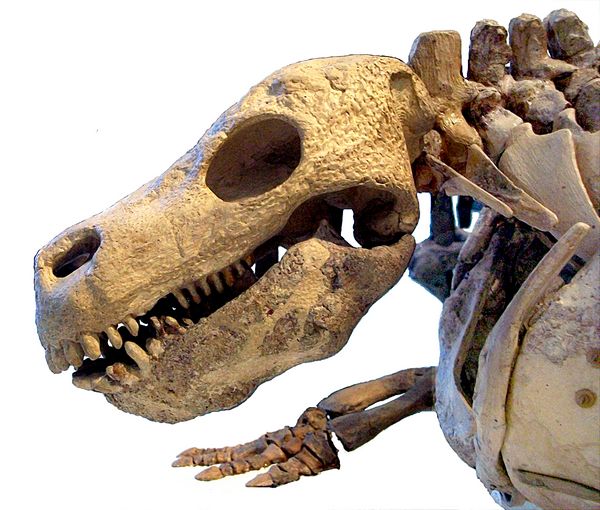Athena Review Image Archive ™
Diadectes sideropelicus

Diadectes sideropelicus (AMNH; photo: Athena Review)
Diadectes sideropelicus was a terrestial, herbivorous amphibian from the Early Permian Cisuralian phase (290-272 mya), first found by Cope in 1878 in the red beds of the Permian Basin of northern Texas, near Wichita Falls. The name Diadectes sideropelicus means "crosswise biter from iron clay", from dia- "crosswise" and dectes "biter"(Gk.); sideros "iron", and pelos "clay." It belongs to the class Amphiba, the order Reptilomorpha, and the suborder Diadectomorpha. The type speciment AMNH 4684 (American Museum of Natural History) consists of a skull and skeleton, as shown in this image.
Diadectes has both reptilian and amphibian traits, combining a reptile-like skeleton with a more primitive, seymouriamorph-like skull. Diadectes has been classified as belonging to the sister group of the amniotes (vertebrates with eggs protected by shells and amniotic fluid). The body length was 1.5 to 3 meters long. Diadectes was one of the first fully terrestrial animals to attain large size. It has a robust skeleton, with a thick-boned skull, heavy vertebrae and ribs, massive limb girdles, and short, robust limbs.
Diadectes was one of the very first herbivorous
tetrapods, as indicated by its teeth which show advanced specializations for
herbivorous diet. Eight front teeth are spatulate and peg-like, serving
as incisors to nip off mouthfuls of vegetation. The broad,blunt cheek
teeth show extensive wear associated with occlusion, serving as
molars. Among
its primitive features, Diadectes has a large otic notch (a feature
found in all labyrinthodonts; but not in reptiles) with an ossified
tympanum.
References:
Cope 1878
Copyright © 1996-2020 Rust Family Foundation (All Rights Reserved).